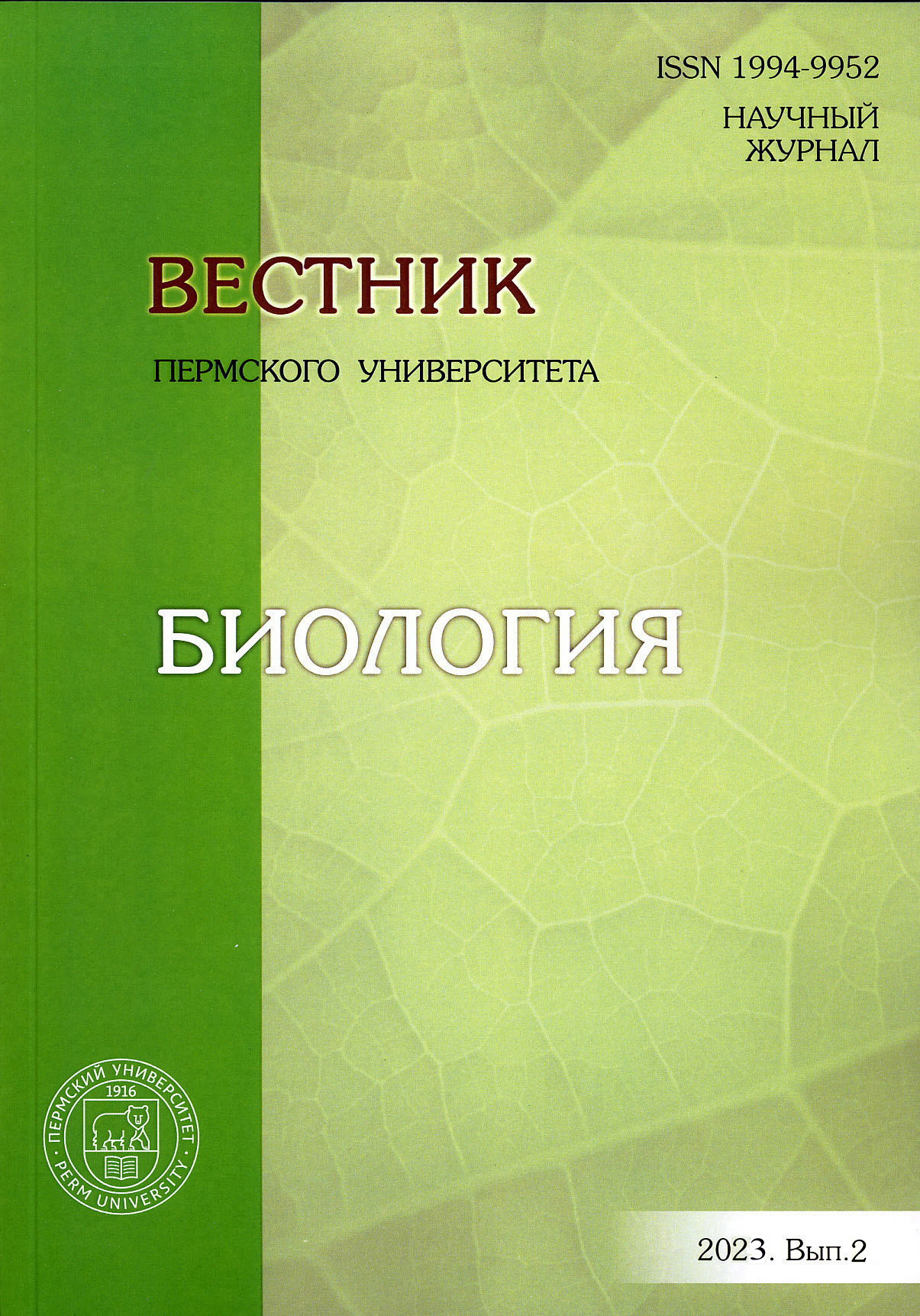Destruction of phthalic acids by Paenarthrobacter sp. SA101 isolated from the wastewater of a chemical plant
Main Article Content
Abstract
Article Details
References
Зайцев Г.М., Карасевич Ю.Н. Утилизация 4 хлорбензойной кислоты штаммом Arthrobacter globi-formis // Микробиология. 1981. Т. 50. С. 35 40.
Егорова Д.О. и др. Деструкция ароматических углеводородов штаммом Rhodococcus wratislaviensis КТ112-7, выделенным из отходов соледобывающего предприятия // Прикладная биохимия и микробио-логия. 2013. Т. 49, № 3. С. 267–278.
Малышева А.А., Ястребова О.В., Плотникова Е.Г. Выделение и характеристика штамма-деструктора сложных эфиров фталевой кислоты Paenarthrobacter sp. SA101 // Фундаментальные и при-кладные аспекты биоинформатики, биотехнологии и недропользования: сб. статей всерос. науч. конф. с междунар. участием. Пермь, 2021. С. 69–71.
Нетрусов А.И. Практикум по микробиологии. М.: Академия, 2005. 608 с.
Ястребова О.В., Малышева А.А., Плотникова Е.Г. Галотолерантные бактерии рода Glutamicibacter – деструкторы терефталевой кислоты // Прикладная биохимия и микробиология. 2022. Т. 58, № 5. С. 476–483.
Benjamin S. et al. A monograph on the remediation of hazardous phthalates // J. Hazard. Mater. 2015. Vol. 298. P. 58–72.
Boll M. et al. Minireview. Microbial degradation of phthalates: biochemistry and environmental implica-tions // Environ. Microbiol. Reports. 2020. Vol. 12(1). P. 3–15.
Chen F. et al. High-efficiency degradation of phthalic acid esters (PAEs) by Pseudarthrobacter defluvii E5: Performance, degradative pathway, and key genes // Sci. Total Environ. 2021. Vol. 794 : 10. doi: 10.1016/j.scitotenv.2021.148719. 48719.
Dagley S. Catabolism of aromatic compounds by microorganisms // Adv. Microb. Physiol. 1971. Vol. 6. P. 1–46.
Eaton R.W. Plasmid-encoded phthalate catabolic pathway in Arthrobacter keyseri 12B // J. Bacteriol. 2001. Vol. 183. P. 3689‒3703.
Gao D. et al. An overview of phthalate acid ester pollution in China over the last decade: Environmental occurrence and human exposure // Sci. Total Environ. 2018. Vol. 645. P. 1400–1409.
Kallimanis A. et al. Complete genome sequence of Arthrobacter phenanthrenivorans type strain (Sphe3) // Stand. Genomic Sci. 2011. Vol. 4. P. 123–30.
Karthik M. et al. Biodegradability enhancement of purified terephthalic acid wastewater by coagulation–flocculation process as pretreatment // J. Hazard. Mater. 2008. Vol. 154. P. 721‒730.
Liang D.W., Zhang T., Fang H. Phthalates biodegradation in the environment // Appl. Microbiol. Bio-technol. 2008. Vol. 80. P. 183–198.
Marko M.A., Chipperfield R., Birnboim H.C. A procedure for the large-scale isolation of highly purified plasmid DNA using alkaline extraction and binding to glass powder // Analit. Biochem. 1982. Vol. 121. P. 382–387.
Mihăşan M. et al. Time-dependent analysis of Paenarthrobacter nicotinovorans pAO1 nicotine-related proteome // ACS Omega. 2021. Vol. 6. P. 14242−14251.
Ren C. et al. Complete degradation of di-n-butyl phthalate by Glutamicibacter sp. strain 0426 with a novel pathway // Research Square. 2023. doi.org/10.21203/rs.3.rs-2696404/v1.
Shariati S. et al. Degradation of dibutyl phthalate by Paenarthrobacter sp. Shss isolated from Saravan landfill, Hyrcanian Forests, Iran // Biodegradation. 2022. Vol. 33. P. 59–70.
Stanislauskienė R., Rudenkov M., Karvelis L. Analysis of phthalate degradation operon from Arthrobac-ter sp. 68b // Biologija. 2011. Vol. 57. P. 45–54.
Suwanawat N. et al. Biodegradation of terephthalic acid by Rhodococcus biphenylivorans isolated from soil // Int. J. Environ. Sci. Dev. 2019. Vol. 10. P. 30‒33.
Wang Z. et al. Environmental health risks induced by interaction between Phthalic Acid Esters (PAEs) and biological macromolecule: A review // Chemosphere. 2023. Vol. 4. 138578. doi: 10.1016/j..138578.
Zhang M. et al. Comparative genomic analysis of iprodione-degrading Paenarthrobacter strains reveals the iprodione catabolic molecular mechanism in Paenarthrobacter sp. strain YJN-5 // Environ. Microbiol. 2021. Vol. 23. P. 1079–1095.
Zhang X. et al. Purified terephthalic acid wastewater biodegradation and toxicity // J. Environ. Sci. (Chi-na). 2005. Vol. 17(5). P. 876‒880.
Zhang Y.M. et al. Degradation of terephthalic acid by a newly isolated strain of Arthrobacter sp. 0574 // South African J. of Science. 2013. Vol. 109. doi.org/10.1590/ sajs.2013/20120019.




